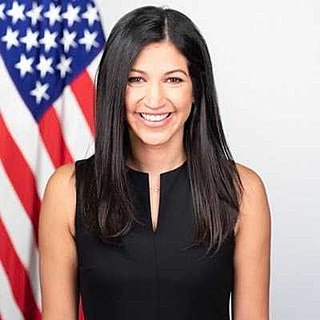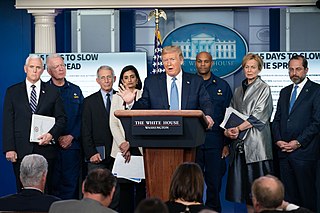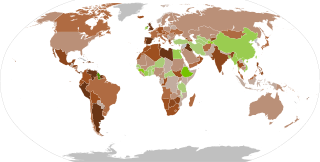Some national leaders, [1] including heads of state and heads of government have tested positive for COVID-19 while in office.

Marc T. Short is an American political advisor who served as chief of staff to Vice President Mike Pence. Prior to holding this role, Short was the director of legislative affairs at the White House from 2017 to 2018. He became chief of staff for Pence in March 2019. He was a senior fellow at the Miller Center of Public Affairs, a CNN contributor, chief of staff to Senator Kay Bailey Hutchison, and the House Republican Conference. He was president of Freedom Partners Chamber of Commerce from 2011 to 2016. He was a frequent guest on Meet The Press of NBC News.
The following is a list of notable events, births and deaths from 2020 in the United States.

Katie Rose Miller is an American political advisor who served as the communications director for the Vice President of the United States Mike Pence from 2020 to 2021. She was previously his press secretary from 2019 to 2020.
Events in the year 2020 in the Russian Federation.
2020s in United States history is a narrative summary of major historical events and issues in the United States from January 1, 2020, through December 31, 2029. The first part is divided chronologically by Congressional sessions and the second part highlights major issues that span several years or even the entire decade. There are links for further information.

On December 31, 2019, China announced the discovery of a cluster of pneumonia cases in Wuhan. The first American case was reported on January 20, and President Donald Trump declared the U.S. outbreak a public health emergency on January 31. Restrictions were placed on flights arriving from China, but the initial U.S. response to the pandemic was otherwise slow, in terms of preparing the healthcare system, stopping other travel, and testing. The first known American deaths occurred in February. On March 6, 2020, Trump allocated $8.3 billion to fight the outbreak and declared a national emergency on March 13. The government also purchased large quantities of medical equipment, invoking the Defense Production Act of 1950 to assist. By mid-April, disaster declarations were made by all states and territories as they all had increasing cases. A second wave of infections began in June, following relaxed restrictions in several states, leading to daily cases surpassing 60,000. By mid-October, a third surge of cases began; there were over 200,000 new daily cases during parts of December 2020 and January 2021.

The COVID-19 pandemic was confirmed to have reached the U.S. state of North Carolina on March 3, 2020.
The COVID-19 pandemic in Tanzania was a part of the ongoing worldwide pandemic of coronavirus disease 2019 caused by severe acute respiratory syndrome coronavirus 2. The COVID-19 pandemic was confirmed to have reached Tanzania in March 2020.
Events of 2020 in Tanzania.
The following is a timeline of the COVID-19 pandemic in the United States during 2020.

In connection with the COVID-19 pandemic, navies from several countries deployed hospital ships to combat the disease. Aside from providing health services, hospital ships would allow civilian hospitals to offload some of the patients, relieving the pressure on facilities ashore. However, this also means that each ship would battle the onboard outbreaks of their own

The Donald Trump administration communicated in various ways during the COVID-19 pandemic in the United States, including via social media, interviews, and press conferences with the White House Coronavirus Task Force. Opinion polling conducted in mid-April 2020 indicated that less than half of Americans trusted health information provided by Trump and that they were more inclined to trust local government officials, state government officials, the Centers for Disease Control and Prevention (CDC), and National Institute of Allergy and Infectious Diseases director Anthony Fauci.

The economic impact of the COVID-19 pandemic in the United States has been widely disruptive, adversely affecting travel, financial markets, employment, shipping, and other industries. The impacts can be attributed not just to government intervention to contain the virus, but also to consumer and business behavior to reduce exposure to and spread of the virus.

The wearing of non-medical face masks in public to lessen the transmission of COVID-19 in the United States was first recommended by the CDC on April 3, 2020, as supplemental to hygiene and appropriate social distancing. Throughout the pandemic, various states, counties, and municipalities have issued health orders requiring the wearing of non-medical face coverings — such as cloth masks — in spaces and businesses accessible to the public, especially when physical distancing is not possible.

The federal government of the United States initially responded to the COVID-19 pandemic in the country with various declarations of emergency, some of which led to travel and entry restrictions and the formation of the White House Coronavirus Task Force. As the pandemic progressed in the U.S. and globally, the U.S. government began issuing recommendations regarding the response by state and local governments, as well as social distancing measures and workplace hazard controls. State governments played a primary role in adopting policies to address the pandemic. Following the closure of most businesses throughout a number of U.S. states, President Donald Trump announced the mobilization of the National Guard in the most affected areas.

The White House COVID-19 outbreak was a cluster of SARS-CoV-2 infections that began in September 2020 and ended in January 2021 that spread among people, including many U.S. government officials, who were in close contact during the COVID-19 pandemic in Washington, D.C. Numerous high-profile individuals were infected, including then President Donald Trump, who was hospitalized for three days. At least 48 White House staff members or associates, closely working with White House personnel, tested positive for the virus. The White House resisted efforts to engage in contact tracing, leaving it unclear how many people were infected in total and what the origins of the spread were.

Misinformation related to the COVID-19 pandemic has been propagated by various public figures, including officials of the United States government. The Trump administration in particular made a large number of misleading statements about the pandemic. A Cornell University study found that former U.S. President Donald Trump was "likely the largest driver" of the COVID-19 misinformation infodemic in English-language media, downplaying the virus and promoting unapproved drugs. Others have also been accused of spreading misinformation, including U.S. Secretary of State Mike Pompeo, backing conspiracy theories regarding the origin of the virus, U.S. senators and New York City mayor Bill de Blasio, who downplayed the virus.

During the worldwide COVID-19 pandemic, many people began to spread false or un-confirmed data and information. This included politicians and other government officials from administrations in several countries. Misinformation about the virus includes its origin, how it spreads, and methods of preventing and curing the disease. Some downplayed the threat of the pandemic, and made false statements about preventative measures, death rates and testing within their own countries. Some have also spread COVID-19 vaccine misinformation. Changing policies also created confusion and contributed to the spread of misinformation. For example, the World Health Organization (WHO) originally discouraged use of face masks by the general public in early 2020, advising "If you are healthy, you only need to wear a mask if you are taking care of a person with suspected 2019-nCoV infection," although the WHO later changed their advice to encourage public wearing of face masks.
The following is a timeline of the presidency of Joe Biden during the first quarter of 2021, beginning from his inauguration as the 46th president of the United States on January 20, 2021, to March 31, 2021. To navigate between quarters, see timeline of the Joe Biden presidency. For the Q2 timeline see timeline of the Joe Biden presidency.

The United States' response to the COVID-19 pandemic with consists of various measures by the medical community; the federal, state, and local governments; the military; and the private sector. The public response has been highly polarized, with partisan divides being observed and a number of concurrent protests and unrest complicating the response.